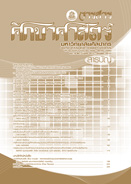การศึกษาปฏิสัมพันธ์ระหว่างการเรียนวิชาวิทยาศาสตร์แบบผสมผสานที่มีระดับการสืบเสาะต่างกันกับผู้เรียนที่มีกลุ่มพหุปัญญาต่างกัน ที่ส่งผลต่อการคิดอย่างมีวิจารณญาณของนักเรียนชั้นมัธยมศึกษาปีที่ 3
Main Article Content
บทคัดย่อ
ผลการวิจัย พบว่า
1. นักเรียนที่เรียนจากการเรียนแบบผสมผสาน ที่มีระดับการสืบเสาะต่างกัน มีคะแนนการคิดอย่างมีวิจารณญาณไม่แตกต่างกันอย่างมีนัยสำคัญทางสถิติที่ระดับ .05
2. นักเรียนที่เรียนจากการเรียนแบบผสมผสาน ที่มีกลุ่มพหุปัญญาต่างกัน มีคะแนนการคิดอย่างมีวิจารณญาณไม่แตกต่างกันอย่างมีนัยสำคัญทางสถิติที่ระดับ .05 และ
3. มีปฏิสัมพันธ์ระหว่างการเรียนแบบผสมผสานที่มีระดับการสืบเสาะต่างกัน ต่อการคิดอย่างมีวิจารณญาณของนักเรียนที่มีกลุ่มพหุปัญญาต่างกันอย่างมีนัยสำคัญทางสถิติที่ระดับ .05
A STUDY OF THE INTERACTION BETWEEN SCIENCE SUBJECT BLENDED LEARNING WITH DIFFERENT INQUIRY LEVELS AND STUDENTS WITH DIFFERENT MULTIPLE INTELLIGENCES AFFECTING CRITICAL THINKS OF MATTAYOM SUKSA III STUDENTS
The purpose of the study were 1) to compare the scores of critical thinking of students trained by blended learning method with different levels of inquiry 2) to compare the scores of critical thinking of students with multiple intelligences and 3) to study the interaction among blended learning with different levels of inquiry. The subject consisted of the ninety of the ninth grade of the Municipality 5 School Paholyotinramintarapakdee Ratchaburi province. The research instruments used for this study were: 1) Blended learning method with different levels of inquiry with both in class and e-learning activities 2) Critical thinking test 3) Lesson plan evaluation form 4) Gardner’s multiple intelligences test 5) E-learning lesson evaluation form and 6) Inquiry learning activity evaluation form. The data were analyzed by using the following statistics: 1) basic statistics 2) independent t – test 3) One-way ANOVA and 4) Two-way ANOVA
The results of the study were as follows:
1) The critical of thinking scores each blended learning group of students with different levels of inquiry were not statistic significantly different among each group at 0.05 level.
2) The critical thinking scores of each blended learning group of students with multiple intelligences were not statistic significantly different among each group at 0.05 level.
3) There was an interaction toward critical thinking between the blended learning with different levels of inquiry students and the multiple intelligences group with statistically significant at level of 0.05

